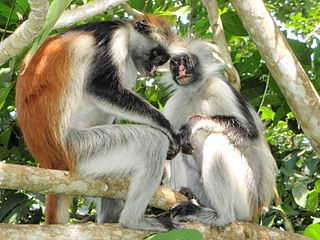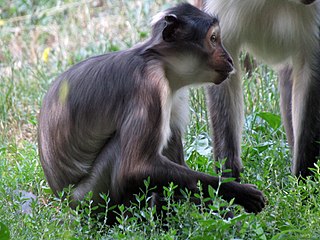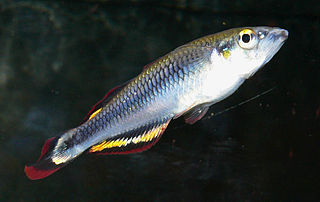
Cyprinus is the genus of typical carps in family Cyprinidae. Most species in the genus are of East Asia origin with only the common carp in Western Asia and Europe; this invasive species has also been introduced to many other regions around the world. Cyprinus are closely related to some more barb-like genera, such as Cyclocheilichthys and Barbonymus (tinfoils). The crucian carps (Carassius) of western Eurasia, which include the goldfish, are apparently not as closely related.

The macaques constitute a genus (Macaca) of gregarious Old World monkeys of the subfamily Cercopithecinae. The 23 species of macaques inhabit ranges throughout Asia, North Africa, and Europe. Macaques are principally frugivorous, although their diet also includes seeds, leaves, flowers, and tree bark. Some species such as the long-tailed macaque will supplement their diets with small amounts of meat from shellfish, insects, and small mammals. On average, a southern pig-tailed macaque in Malaysia eats about 70 large rats each year. All macaque social groups are arranged around dominant matriarchs.

The surilis are a group of Old World monkeys in the genus Presbytis. They live in the Thai-Malay Peninsula, on Sumatra, Borneo, Java and smaller nearby islands. Besides surili, the common names for the monkeys in the genus also often use the terms "langur" or "leaf monkey."

Red colobuses are Old World monkeys of the genus Piliocolobus. It was formerly considered a subgenus within the genus Procolobus, which is now restricted to the olive colobus. They are closely related to the black-and-white colobus monkeys, and some species are often found in groups with the blue monkey. The western red colobus is frequently hunted by the common chimpanzee.

The white-eyelid mangabeys are African Old World monkeys belonging to the genus Cercocebus. They are characterized by their bare upper eyelids, which are lighter than their facial skin colouring, and the uniformly coloured hairs of the fur. The other two genera of mangabeys, Lophocebus and Rungwecebus, were once thought to be very closely related to Cercocebus, so much so that all the species were placed in one genus, but Lophocebus and Rungwecebus species are now understood to be more closely related to the baboons in genus Papio, while the Cercocebus species are more closely related to the mandrill.

Bedotia is a genus of the family Bedotiidae of fishes endemic to Madagascar.
Sinogastromyzon is a genus of hillstream loaches native to eastern Asia.

Chiloglanis is a genus of upside-down catfishes native to Africa. These species have modified lips and barbels that form a suckermouth. They also have a naked (scaleless) body. Sexual dimorphism has been reported in Chiloglanis. The adult males of many of these species have elongate anal and caudal fins. Also, males may have an enlarged humeral process.

The red-tailed silverside, or zona is a species of Madagascar rainbowfish endemic to the Mananjary River drainage in Madagascar. It is threatened by habitat loss and introduced species. It has often been confused with the related B. madagascariensis, which is common in the aquarium trade. In addition to meristics, the two can be separated by the exact colour pattern on their tail fin and the distinct red spot on the lower jaw of breeding male B. geayi. B. geayi was described in 1907 by Jacques Pellegrin from a type collected by the pharmacist and natural history collector Martin François Geay (1859-1910), who Pellegrin honoured with its specific name.

Kneria is a genus of small fish in the family Kneriidae. All 13 species in this genus are restricted to Africa.

Marcusenius is a genus of the elephantfish group native to Africa. Its members are highly diverse in size, with the smallest species reaching less than 15 cm (6 in) and the largest more than 1 m (3.3 ft).
Aubregrinia is a genus of plant in the family Sapotaceae first described as a genus in 1935.

Turraeanthus africanus is a species of plant in the family Meliaceae, also known by the common names avodiré, apeya, engan, agbe, lusamba, wansenwa, African satinwood, and African white mahogany.

The serows are four species of medium-sized goat-like or antelope-like mammals of the genus Capricornis. All four species of serow were until recently also classified under Naemorhedus, which now only contains the gorals.
Synodontis albolineatus, known as the mustard catfish, or the mustard squeaker, is a species of upside-down catfish native to Gabon and Cameroon, where it occurs in the Ntem and Ivindo rivers. It was first described by French zoologist Jacques Pellegrin in 1924, based upon a holotype discovered in the Djoua River at Madjingo, Gabon. The holotype specimen resides in the Musee National d' Histoire Naturelle de Paris. The specific name "albolineatus" is a composite from the Latin word albus for "white" and the Latin word linea for "line", which refers to the white midlateral stripe of the species.

Labeobarbus is a mid-sized ray-finned fish genus in the family Cyprinidae. Its species are widely distributed throughout eastern Africa and especially southern Africa, but also in Lake Tana in Ethiopia. A common name, in particular for the southern species, is yellowfish. The scientific name refers to the fact that these large barbs recall the fairly closely related "carps" in the genus Labeo in size and shape. As far as can be told, all Labeobarbus species are hexaploid.
Enteromius guineensis is a species of ray-finned fish in the genus Enteromius. It is restricted to the Upper Konkouré River system in the Fouta Djalon highlands in Guinea.

Cincelichthys is a genus of high-bodied cichlids found in southern Mexico to Guatemala, where they inhabit lakes, rivers and other freshwater habitats. They are large cichlids, up to 35–42.5 cm (14–17 in) long depending on species, with females reaching smaller sizes than males.














